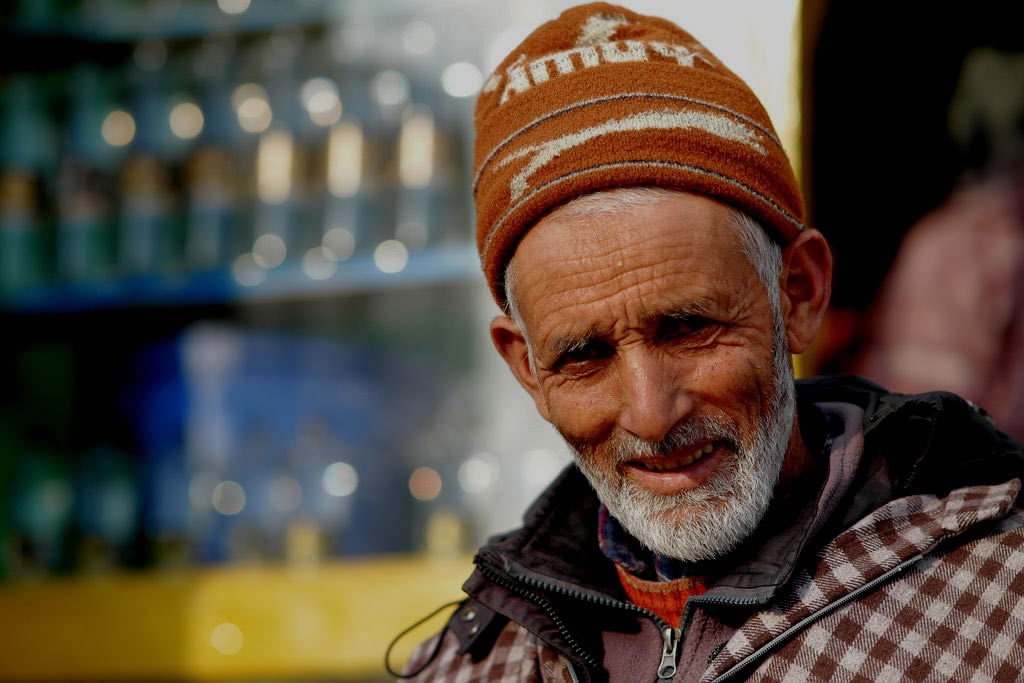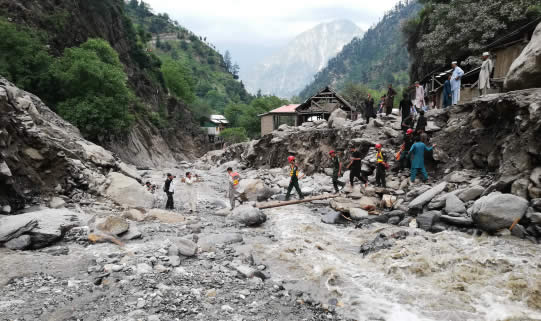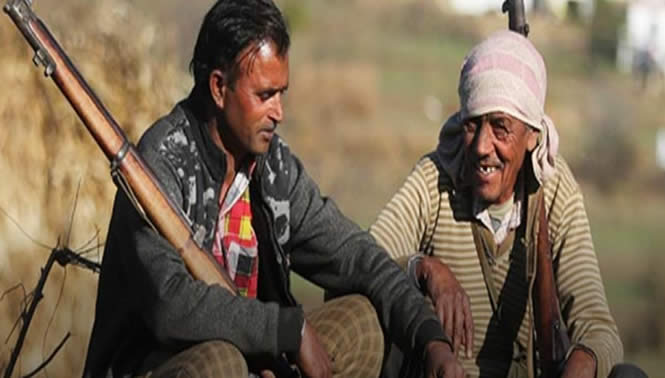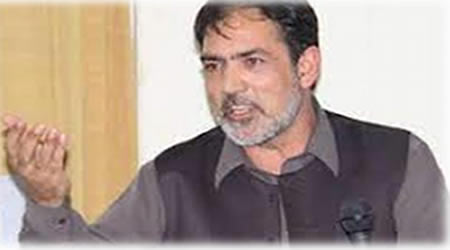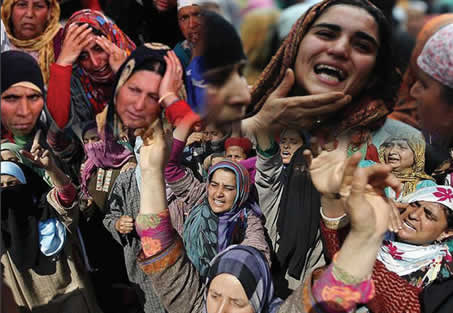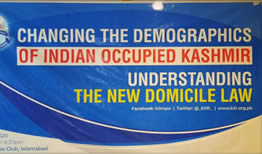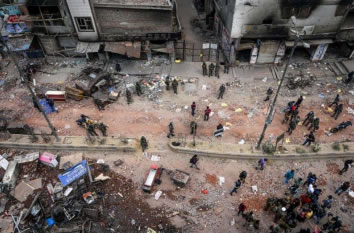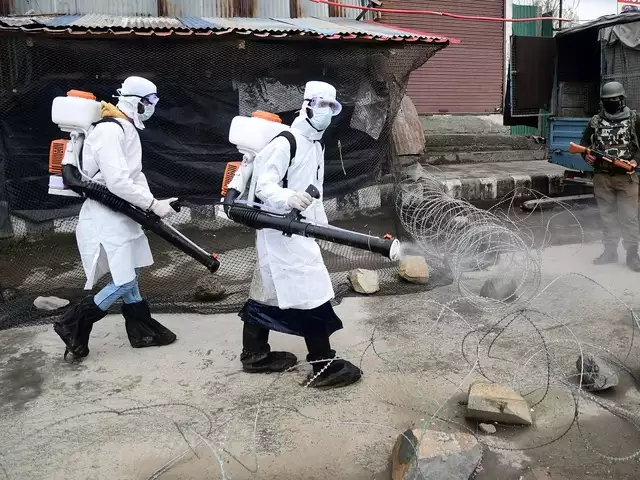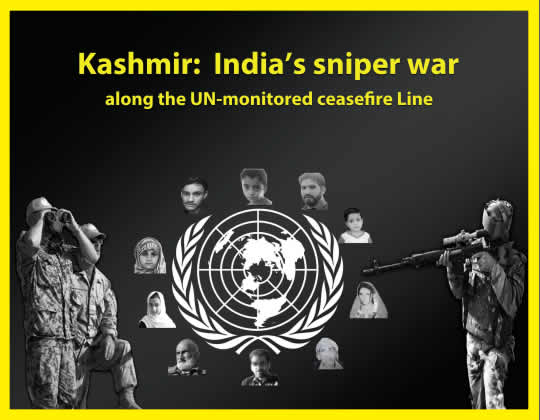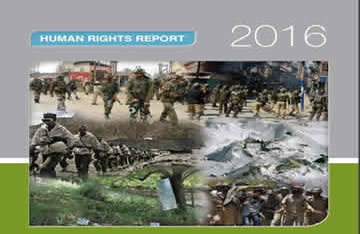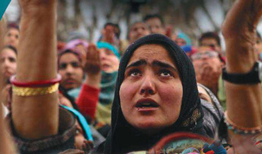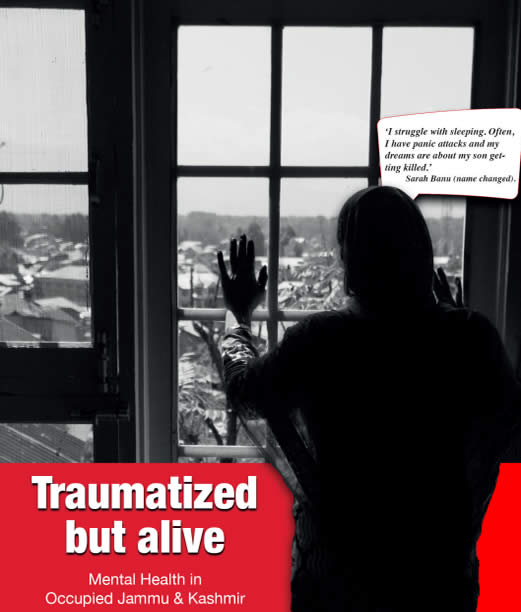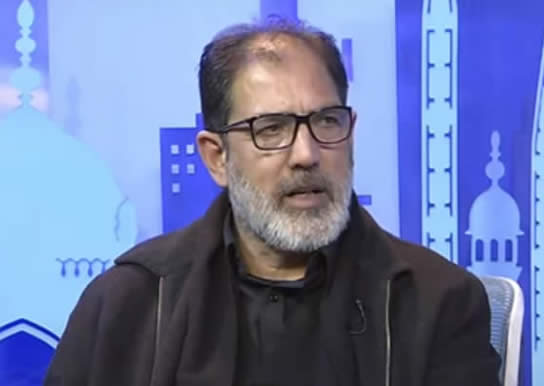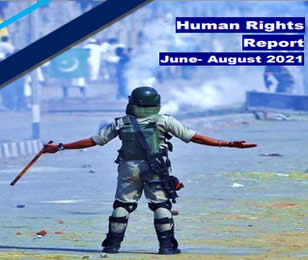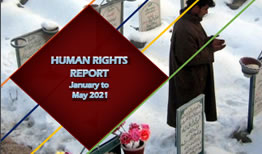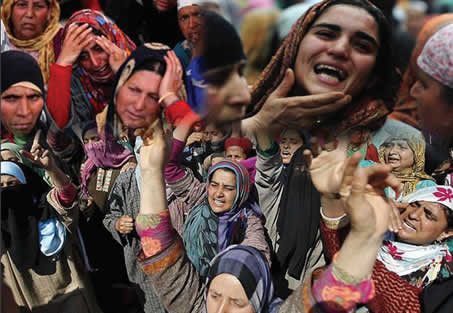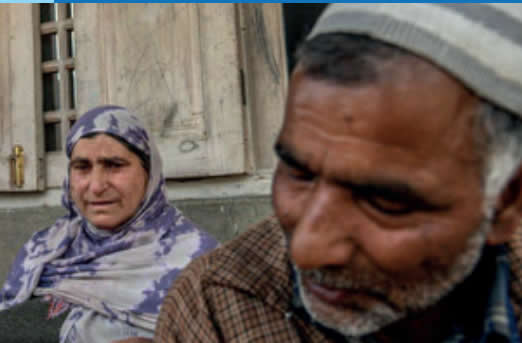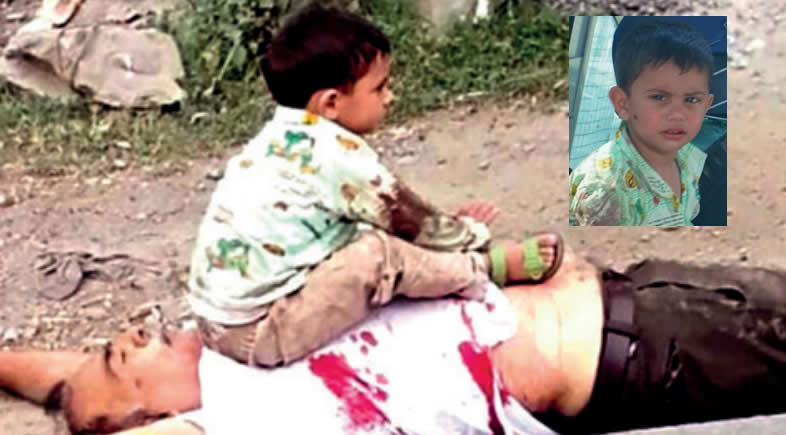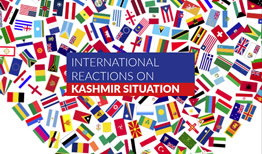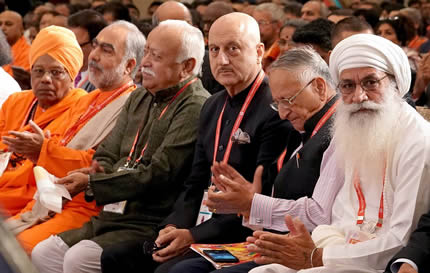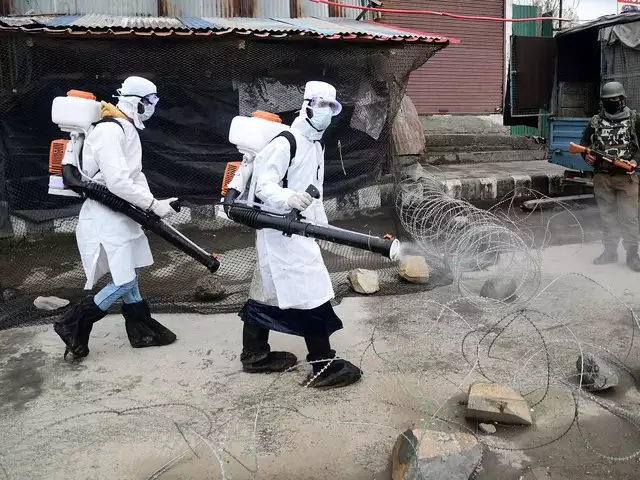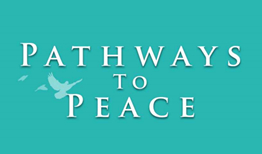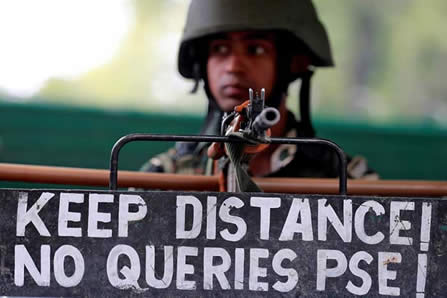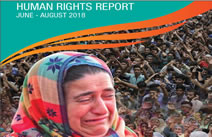TOWARDS ANNEXATION & INDIANIZATION OF KASHMIR IN BROAD DAYLIGHT
Acknowledgements
This work would not have been possible without the generous support and guidance of Altaf Hussain Wani, Chairman Kashmir Institute of International Relations (KIIR), Islamabad. Besides sharing his insight on different dimensions of the Kashmir struggle, he also took it upon himself to fetch the information and documents which were instrumental in shaping up this study.
Mr. Wani has remained associated with the freedom struggle in Kashmir since its early days in 1980s and, hence, his acumen and vast knowledge on the subject is always thoroughly inspiring and helpful.
My special thanks are also due to Ershad Mahmud, Executive Director Center for Peace, Development and Research (CPDR) and Dr. Farhan Mujahid Chak, Associate Professor of International Affairs at Qatar University, Qatar, for their invaluable feedback and suggestions that greatly improved the manuscript, although errors and shortcomings are still expected that belong to the writer only and he owns them.
Last but not the least, I am grateful to advocate Mujtaba and Mr. Mehr-ur-Nisa Director Reserach KIIR for their assistance in background research fact-designing and formatting of this report.
Acronyms
AJ&K Azad Jammu & Kashmir
AGMUT Arunachal Pradesh-Goa-Mizoram-Union Territory
ANC Awami National ConferenceBJP
BJP Bhartiya Janta Party
CP Congress Party
CPI-M Communist Party of India-Marxist
DDC District Development Council
DGP Director General of Police
GB Gilgit-Baltistan
ICJ International Court of Justice
IPS Indian Police Service IAS Indian Administrative Service
INC Indian National Congress
J&K Jammu and Kashmir
JI Jammat-e-Islami
J&KPC Jammu and Kashmir People’s Conference
JKLF Jammu and Kashmir Liberation Front
NC National Conference
NIOS National Institute of Open Schooling
PDP Peoples Democratic Party
PHEIFCD Public Health Engineering, Irrigation and Flood Control Department
PML-N Pakistan Muslim League-Nawaz
PPP Pakistan Peoples Party
PRC Permanent Resident Certificate
SKICC Sher-e-Kashmir International Convention Centre
SKIMS Sher-e-Kashmir Institute of Medical Science
UN United Nations
UNSC United Nations Security Council
UT Union Territory
Preface
On August 5, 2019, India abrogated Articles 370 and 35A of its constitution which granted a special status to the State of Jammu and Kashmir. Following protracted negotiations with the interim government of the held-State, India had agreed to adopt these two articles in early 1950s, which, despite being eroded tremendously over a period of time, remained a bulwark against Delhi’s endeavors to assimilate J&K into India beyond recognition.
The obtaining situation posits a great challenge to both the Kashmiris as a nation, and their supporters and sympathizers the world over to turn tables back on India as the actions taken by it on the heels of the constitutional changes, such as introduction of a new domicile law, give an unveiled indication that it is predetermined to obliterate fundamental realities in Kashmir to pave the way for settler colonialism.
This report is an attempt to document the steps taken by India in recent months to perpetuate and enhance its control over Kashmir. The report also sheds light on the Indian endeavors to change the demography of Kashmir, besides monopolizing its natural resources by leaving hardly any place for the native Kashmiris to protect their honor, dignity, language, culture and national identity
The writer has used qualitative method to prepare this report, and has benefitted from the wisdom and expertise of numerous scholars, policy makers and media persons.
Key Findings
- Abrogation of the constitutional status of Jammu & Kashmir is not a random occurrence but a part of a well-designed plan to recreate ground realities in the held-State for its Indianization in the shortest possible span of time.
- It was not a sudden or surprising move by India at all, as Hindu nationalists such Shama Prashad MukharJee, founder of Bhartiya Jhang Sangh now BJP, had stood for the complete integration of Kashmir into India. Mukhar Jee was spearheading a strong campaign for it when he died in Srinagar in 1952
- Revocation of the Articles 370 and 35A was part of the election manifesto of Bhartiya Janta Party (BJP) in 2019.
- After the downgrading of the constitutional status of J&K on Aug. 5, 2019; India has introduced around 200 laws (including new and amended ones) to reshape the occupiedState at a horrendous speed.
- J&K has lost its separate status under the Indian constitution and has been dismembered in two Union territories, removing all barriers to assimilate it into Delhi completely
- After the introduction of new domicile law, India is all set to alter the demography of Indian occupied Kashmir by paving the way for the settlement of two million outsiders in J&K.
- The strongest likelihood is that India would further relax the pre-requirements for settlements in J&K, once the criticism on it for changing the demographics of the heldState subsides.
- India has announced to facilitate the safe return of the Pandits to J&K, besides ensuring them full security and protection. However, it has declared in unequivocal terms that the Kashmiri refugees living in Pakistan and Azad Jammu & Kashmir (AJ&K) are no more entitled to “the right to return” to their native places in J&K
- Under different laws, Kashmiris are being disposed of their native land to render them ineffective. For instance, the Indian Army is now entitled to declare any area a “strategic area” and grab it without any legal process under a new law. Now, no “NoC” from any department is required for this action. Already keeping over 4.30 lakh kanals of land under its control, the new law allows the Indian Army to take over even townships and huge settlements under the garb of “strategic area” law.
- The basic identity, history and culture of J&K are also being recalibrated to merge it in to India. According to the new education policy, even the madaris are required to teach basic Hindu scriptures at their campuses to create “national unity and integrity”.
- Hindi has now been declared the official language of J&K in order to destroy Urdu, associated with Islam and Muslim culture in J&K.
- All the landmarks are being renamed in J&K after fanatic Hindus, such as Sardar Patel and Mukher Jee, who are known for their proven anti-Islam and anti-Muslim standpoint.
- With zero space for APHC and pro-independence leadership, India is engaged in creation of a dummy political leadership in J&K. “Apni Party” like organizations are being encouraged to promote “development-oriented politics” to dissuade the Kashmiri people from pro-independence political parties.
- As part of a sinister plan, Kashmiris are being removed from the top administrative positions. Today, there is hardly any Kashmiri Muslim serving at a top position in the administrative sector, including police, in J&K.
- A large number of Kashmiris are faced with the threat to lose their jobs for their involvement in “anti-national activities”. It shall aggravate unemployment issue in the occupied State
- Despite continued human rights violations in the held Kashmir, international community has not been able to exert due pressure on India to desist from changing fundamental realities in the area
- Pakistan has to rephrase its narrative on Kashmir quite artistically. It should certainly stress on the revival of the Articles 370 and 35A, and at the same time, underline clearly that the real issue remains to be the non-implementation of UNSC resolutions on Kashmir.
Kashmir Issue: a Brief Introduction
Prior to 1947 when India and Pakistan came into being as two sovereign dominions, the State of Jammu and Kashmir existed as one of the 565 princely states that were not under the direct control of the British colonial administration1 . Keeping in view their geographical congruity and faith of the population, they were given a choice to join either Pakistan or India2 . As a Muslim majority state spreading over 86,000 sqm3 , Kashmir was widely believed to become a part of Pakistan but its ruler fraudulently acceded to India, which resulted in a public uprising against him. Consequently, one third of Kashmir, comprising present day Azad Jammu & Kashmir and GilgitBaltistan (GB) was liberated from India through an armed struggle.
In 1947, India itself took the issue to the UN Security Council, which on January 5, 1949 passed a momentous resolution, giving the Kashmiris the right to decide about their future through an UN-supervised plebiscite. Notwithstanding its solemn commitment made before the world to honor this resolution, India gradually backed out from its commitment and declared Kashmir its integral part; not open for negotiation or any bargain4
Continued disregard to the UNSC resolutions on the issue coupled with application of ruthless force, torture and mayhem against freedom-seeking Kashmiris have resulted into four major wars between India and Pakistan on the issue since 1947. The current phase of the struggle for liberation from the Indian occupation goes back to late 80s which witnessed killing, maiming and incarceration of over half a million innocent Kashmiris. In a total disregard to international human rights reports and condemnation, India has gone extra miles to silence the Kashmiris through extreme force, torture, mayhem and molestation of women.
On Aug 5, 2019, India went a step ahead and stripped Jammu Kashmir of its special status which it enjoyed within the Indian union, announcing to integrate it with the rest of the country. The decision raised alarm bells in Kashmir as it was a blatant violation of the UN resolutions on the issue which debar both India and Pakistan to take any action prejudice to the disputed status of the territory. These actions are against the spirits of Simla Agreement also which was signed between the two sides in 1972, binding the two nations not to take any unilateral step to alter the status of the territory
Chapter 01
Abrogation of Articles 370 and 35A: An Overview
Background
On August 5, 2019, the Indian government revoked Article 370 and 35A of the constitution which granted internal autonomy to the State of Jammu and Kashmir (J&K). Under the new arrangement, the region stands bifurcated into two union territories: Jammu and Kashmir, and Ladakh; the former declared to have a state legislature while the latter to be ruled directly from New Delhi, the capital of India5 .Speaking in the parliament, the Indian home minister Amit Shah claimed that, “Article 370 is not permanent, we have not changed our stand on it. Both the bills that I am presenting today are for the welfare of the people of Jammu and Kashmir.”6
To preempt potential public reaction, suffocating months-long restrictions were imposed by Delhi like cutting off all modes of communication, including mobile phone service and internet. Even the Indian media, such as India Today, reported that Delhi deployed more than 80,000 additional troops, besides putting 13000 people into custody before and after the decision.7 Moreover, the entire mainstream political leadership of the held-State, including pro-India voices, such as two ex-chief ministers Umar Abdullah and Mahbooba Mufti, were also put behind the bars at undisclosed locations
The revocation of the two articles of the constitution is being widely seen as a step towards virtual Indianization of the State of Jammu and Kashmir, leaving behind no trace of its separate status or independent identity.
What could be the consequences of the constitutional changes made by India? How is it going to undermine the identity of Kashmiris? And, finally, what options do Kashmiris and Pakistan, as one of the principal parties in the Kashmir issue, have to salvage this situation? Before taking up such highly loaded questions, it is pertinent to revisit of the history of the Article 370 and 35A, their significance and the traditional standpoint of different political forces in India on them.
Historical background of the Article 370 and 35A
On October 27, 1947, India formally annexed the State of Jammu and Kashmir after signing a socalled Instrument of Accession with then ruler of the area Mahraja Hari Singh8 . To formalize this relationship, the interim government of Jammu and Kashmir and the constituent assembly of India held detailed discussions which eventually resulted into the creation and subsequent implementation of the Article 370 in 1950. The Article restricted the jurisdiction of Delhi to defense, foreign affairs and communication sectors while leaving rest of the matters at the disposal of the State.
On October 27, 1947, India formally annexed the State of Jammu and Kashmir after signing a socalled Instrument of Accession with then ruler of the area Mahraja Hari Singh8 . To formalize this relationship, the interim government of Jammu and Kashmir and the constituent assembly of India held detailed discussions which eventually resulted into the creation and subsequent implementation of the Article 370 in 1950. The Article restricted the jurisdiction of Delhi to defense, foreign affairs and communication sectors while leaving rest of the matters at the disposal of the State.
Special Provisions for Jammu and Kashmir
Article 370 embodied six special provisions for Jammu and Kashmir:
- It exempted the State from the complete applicability of the Constitution of India. The State was allowed to have its own constitution.
- Jurisdiction of the central government was confined to only three subjects: defense, foreign affairs and communications.
- Other constitutional powers of the central government could be extended to the State only with the concurrence of the State government.
- The 'concurrence' was only provisional. It had to be ratified by the State's Constituent Assembly.
- The State government's authority to give 'concurrence' lasted only until the State constituent assembly was convened. Once the State constituent assembly finalized the scheme of powers and got dispersed, no further extension of powers was possible.
-
Article 370 could be abrogated or amended only upon the recommendation of the State's
Constituent Assembly (Article 370 of the constitution of India, para 14).
Constitutional Guarantee
Article 35A of the Indian Constitution provided a constitutional guarantee that the demographics of Kashmir will not be disturbed through artificial means and interventions. Before formal adoption of it in 1954, it was known as “Jammu and Kashmir State Subjects Law, 1927”9 , introduced by the Maharaja of Kashmir to forestall settlement of outsiders in the State.
Opposition to Article 370 and 35A
Insertion of the Articles 370 and 35A in the Indian constitution immediately gave birth to two schools of thought. The nationalists, commonly known as the Integrationists, vehemently opposed the idea of granting any special position to J&K and demanded full integration of the State into the Indian Union. Their slogan from the beginning was ‘Ek Pradhan, Ek Vidhan, Ek Nishan’ (One PM, One Constitution, One Flag)10 The critics always claimed that the militancy and secessionist movement in J&K was the result of the undue privilege meted out under Article 370.
Spear headed by National Conference, the other school of thought always pleaded for maintaining the special status of J&K. This school strongly contested the argument of their opponents that autonomy was in any way responsible for the emergence of the secessionist movement in J&K. This school strongly supports the restoration of autonomy as the only viable solution to the vexed Kashmir problem11
Anticipated Death of the Constitutional Provisions
As discussed in detail by famous author A. G. Noorani in his book, “Article 370: a Constitutional history of Jammu and Kashmir”, it stands as an undeniable fact that the Indian leadership always looked at the two Articles as a time buying ploy and believed in a strangulated death of these articles over a period of time.
Noorani states that Sheikh Abdullah and Home Minister Sardar Vallabhbhai Patel had serious disagreements over the original draft of Article 370, and it was unilaterally altered by N. Gopalaswamy Ayyangar without the consent of the Sheikh and his colleagues. Nehru told the Lok Sabha on 27th November, 1963 that, “it has been eroded, if I may use the word, and many things have been done in the last few years which have made the relationship of Kashmir with the Union of India very close. There is no doubt that Kashmir is fully integrated …We feel this process of gradual erosion of Article 370 is going on. Some fresh steps are being taken and in the next month or two they will be completed. We should allow it to go on.”12 Noorani quotes the then-Home Minister Gulzari Lal Nanda in the Lok Sabha on 4th December, 1964: “With regard to the rest of India, a state’s powers are to be curbed, and correspondingly those of the Union enlarged, the elaborate procedure laid down in Article 368 will have to be followed. However, in the case of J&K, a mere executive order by the President under Article 370 would suffice.”
Part of BJP Election Manifesto
Since its inception, BJP had stood for the abrogation of the Articles 370 and 35(A), and termed them as one of the principal reasons behind the “secessionist” movement in Kashmir. The party avowed to scrap them after getting into power. It renewed its pledge to revoke these articles in its election manifesto, issued in 2019.
New Domicile Law Issued
After revocation of the constitutional provisions, India has bombarded J&K with around 200 laws, including a new Domicile Law, with an obvious intent to destroy the separate identity of Kashmir and assimilate it in to the Indian Union. 13 Domicile is an official document which establishes a person’s residency, besides entitling him to avail different kinds of benefits. Institutionalizing a system of domination over indigenous people, the new law opens the floodgates of outsiders to gain permanent residency status in Jammu & Kashmir.
Issued in May 2020, the Jammu and Kashmir Grant of Domicile Certificate (Procedure) Rules 202014, declare that non-Kashmiris are eligible for permanent status in the region if they fulfil any of the following preconditions/ perquisites:
Anyone who has resided in Jammu and Kashmir for 15 years
- Anyone who has studied in Jammu and Kashmir for 7 years or appeared in class 10th/12th exams
- All children of the employees of the Central Government who have served in Jammu and Kashmir for ten years (even if they never resided there)
- All migrants who are registered with the Relief and Rehabilitation Commissioner of Jammu and Kashmir
- Refugees from West Pakistan and members of Valmiki community registered as migrants in J&K
- Women residents who married a non-resident of J&K.
After obtaining the certificate, every outsider would automatically qualify for all those rights and privileges which were previously reserved for the Kashmiri natives only. In other words, they are now entitled to hold government jobs and purchase immovable property in J&K.
Fast-tracked Process
The rules to get a J&K domicile explicitly show that New Delhi wants to speed up the process: the certificate has to be issued within 15 days. A fine worth Rs.50 thousand would be imposed on the concerned officer if he fails to issue the certificate within seven days after an applicant successfully appeals the higher authority.
On the other hand, Kashmiri natives are burdened with a complicated domicile-attaining process. Under the new Rules, the existing permanent resident certificates (PRC) of indigenous Kashmiris stand only as an evidentiary proof of their residence, and must be submitted to their district officer in order to obtain a new domicile certificate.15 This requirement aimed at verifying domiciled people of the region unnecessarily burdens Kashmiris with a stringent process. According to the Indian State Minister G. Kishan, more than 32 lakh domicile certificates have already been issued by January 25, 202116
Why the Law Now?
According to the president of BJP, the primary objective of the law is to “spread dignity and equality, giving long due rights to all”. Other stalwarts of the party have also projected it as a “humanitarian gesture” towards persecuted or excluded communities in Jammu and Kashmir. These communities consist of the West Pakistan refugees, members of the Valimiki group, and women who married the non-residents of J&K, who were all excluded from gaining domicile under the previous hereditary domicile law.
Changes that Took Place after the Revocation
- J&K had a separate flag owing to the provisions of Article 370 in the Constitution of India. Now, J&K’s State flag and emblem cease to exist.
- J&K had a bicameral assembly consisting of Legislative Assembly and Legislative Council. Now, J&K has a separate unicameral Assembly and the newly created UT of Ladakh has no State Assembly. 36 positions of the Members of Legislative Council have ceased to exist in J&K and Ladakh.17
- The authority over three key areas i.e., law and order, transfers and appointments of IPS, IAS and ACB will be looked after by the two Lieutenant Governors (LGs) of the two Union territories (UTs) instead of the Chief Minister as per the Presidential Proclamation.18
- The existing State cadre of officers will remain unchanged. However, the new appointments will be made from the Arunachal Pradesh-Goa-Mizoram-Union Territory (AGMUT) cadre.1
- While J&K will continue to have a Chief Secretary and a Director General of Police (DGP), Ladakh Police will be headed by the Inspector General of Police (IGP). The Police of both the UTs will be under the direct control of the Department of Home Affairs, Government of India.20
- The State laws specially meant for the State will continue to remain in force, such as the Jammu and Kashmir Shri Mata Vaishno Devi Shrine Act, 1988; the Jammu and Kashmir Saffron Act, 2007; the Jammu and Kashmir Aerial Ropeways Act, 2002; Sher-i-Kashmir University of Agricultural Sciences and Technology Act, 1982; the Jammu and Kashmir State Sheep and Sheep Products Development Board Act, 1979 etc. There are a total of 166 State laws.21
- The Jammu and Kashmir Benami Transactions (Prohibition) Act, and the Jammu and Kashmir Juvenile Justice (Care and Protection of Children) Act, 2013 are some of the acts which were repealed and replaced by the central laws.22
Key Changes
| Then | Now | ||
Jammu & Kashmir was a state with special status. | Jammu & Kashmir and Ladakh are two Union Territories. | ||
Only citizens of Jammu and Kashmir were allowed to buy land in the State. | People from anywhere in India will be able to buy a property | ||
No ‘outsider’ could settle in the State. | Any citizen of the country can settle in J&K. | ||
Cases regarding the Right to Information (RTI)
could not be filed | No restriction on filing cases regarding RTI | ||
Period of Legislative Assembly was 6 years. | Now, the tenure of the Legislative Assembly
will not be six years. | ||
Jammu & Kashmir had a separate flag. | Only the National Flag of India will be there. | ||
J&K had a separate constitution. | There will be no separate constitution for J&K,
law & order will be under the central
government. | ||
Ladakh was a part of Jammu & Kashmir | Ladakh will be a separate Union Territory
without a legislature. |
Chapter 2
Revocation of Special Status of Kashmir: Legal and Constitutional Dimensions
While the revocation of the special status of Jammu and Kashmir under the Indian constitution smacks of Delhi’s game plan to rewrite the history of the erstwhile State and turn it into a settler colony, it is also important to take a critical look at it in the light of international conventions and agreements. For academic purpose, it is essential to start off with a brief reference to the Indian law
Revocation of Article 370 Legal under Indian Law?
Described as a “temporary provision”, Article 370 of the Indian constitution granted a special status to J&K wherein the jurisdiction of India extended only to three matters: defense, foreign affairs, and communications.23 Other matters in the legislative subject lists could apply to the State only with the “concurrence of the Government of the State” through a presidential order.
However, the Article also mentions clearly that the president of India can amend or repeal it himself through an order provided that “the recommendation of the Constituent Assembly of the State” is given before any such notification24. Since the Constituent Assembly was dissolved on January 25, 1957; without the recommendation of the abrogation of the article, several decisions by the High Court of Jammu and Kashmir and the Supreme Court of India (including State Bank of India vs Santosh Gupta and Anr)25 have held that the article “will continue to be in force” and has effectively acquired a permanent status in the constitution.
The revocation of article 370 begs the question even from the standpoint of the Indian constitution. For instance, concurrence of the government of J&K was never received as it did not exist at that moment because of the presidential rule in the area. In such a situation, the Governor is a representative of the Central Government and hence, it defies logic that his recommendation is taken as consent of the Assembly of J&K. In other words, it amounts to the central government taking consent from itself to abrogate an article of the constitution.
Another objection is that article 370(1)(c) (“this Article shall apply in relation to that state”) prevents the President from using his power of amendment in the Constitution (as applicable to Jammu and Kashmir) to amend article 370 himself, even if it is done indirectly. The normal amendment procedure under article 368 could have been utilized.26
Supreme Court of India is hearing fourteen public interest litigation petitions on the issue of Jammu and Kashmir. Some of the petitions relate to challenging the abrogation of article 370, and Jammu and Kashmir’s special status. The petitions remain pending and no substantial action has been taken on them as of today.
Violation of Geneva Convention
Introduction of the new domicile law is a clear violation of the Geneva Convention also. The fourth Geneva Convention bars an occupation force from deporting or transferring its own civilian population into the territory taken over by it. It is a grave breach of Additional Protocol I. Under the Statute of the International Criminal Court, “the transfer, directly or indirectly, by the Occupying Power of parts of its own civilian population into the territory it occupies”27 constitutes a war crime in international armed conflicts.
Many military manuals prohibit the deportation or transfer of its civilian population into the territory it occupies. This rule is included in the legislation of numerous states. Official statements and reported practices also support the prohibition of transferring one’s own civilian population into an occupied territory.
Attempts to alter the demographic composition of an occupied territory have been condemned by the UN Security Council. In 1992, it called for the cessation of attempts to change the ethnic composition of the population, taking place anywhere in the former Yugoslavia. Similarly, the UN General Assembly and UN Commission on Human Rights have condemned such settlement practices. According to the final report of the UN Special Rapporteur on the Human Rights Dimensions of Population Transfer, including the Implantation of Settlers and Settlements, “the implantation of settlers” is unlawful and engages the responsibility of the state and the criminal responsibility of individuals.
In 1981, the 24th International Conference of the Red Cross reaffirmed that “settlements in occupied territory are incompatible with article 27 and 49 of the Fourth Geneva Convention”28.
In the Case of the Major War Criminals in 1946, the International Military Tribunal at Nuremberg found two of the accused guilty of attempting the “Germanization” of the occupied territories29.
International Court of Justice
In its advisory opinion about the legal consequences of the construction of a wall in the Occupied Palestinian Territory in 2004, the ICJ stated the following on the status of Israeli settlements in the Occupied Palestinian Territories:
As regards these settlements, the Courts note that Article 49, paragraph 6, of the Fourth Geneva Convention provides: “The Occupying Power shall not deport or transfer parts of its own civilian population into the territory it occupies.”30 That provision prohibits not only deportations or forced transfers of population such as those carried out during the Second World War, but also any measures taken by an occupying Power in order to organize or encourage transfers or parts of its own population into the occupied territory”.
In this respect, the information provided to the Court shows that since 1977, Israel has conducted a policy and developed practices involving the establishment of settlements in the Occupied Palestinian Territory, contrary to the terms of Article 49, paragraph 6, just cited
The Security Council has thus taken the view that such policy and practices “have no legal validity”. It has also called upon “Israel, as the occupying Power, to abide scrupulously” by the Fourth Geneva Convention and:
“To rescind its previous measures and to desist from taking any action which would result in changing the legal status and geographical nature and materially affecting the demographic composition of the Arab territories occupied since 1967, including Jerusalem and, in particular, not to transfer parts of its own civilian population into the occupied Arab territories31.”
The Council reaffirmed its position in resolutions 452 (1979) of 20th July, 1979 and 465 (1980) of 1st March, 1980. Indeed, in the latter case, it described “Israel’s policy and practices of settling parts of its population and new immigrants in [the occupied] territories” as a “flagrant violation” of the Fourth Geneva Convention. The Court concludes that the Israeli settlements in the Occupied Palestinian Territory (including East Jerusalem) have been established in breach of the international law32
Chapter 3
Indianization of Kashmir: Elements of the Settler Plan
Abrogation of the constitutional provisions and the subsequent swift steps taken are an indication of the Indian resolve to obviate fundamental realities in Jammu and Kashmir in order to assimilate it into the Indian union beyond recognition. As hinted by Sandeep Chakravorty, Indian Consul General in New York33, India has clearly decided to apply the time-tested models of colonization of the occupied territories.
Seen in the backdrop of the August 5, 2019 happening; India is unambiguously implanting settler colonialism in Kashmir which is bound to have serious consequences if not challenged in an equally calculated and measured manner. Before going into the details of this plan, it is important to have a clear understanding of the concept called “settler colonialism” and a brief reference to its history in different parts of the world.
Two Models of Colonialism
Settler colonialism primarily relates to the occupation of a foreign land by a dominant power. This inevitably results into the dispossession of those who originally lived there, causing conflict.
As underlined by Patrick Wolfe34, an Australian historian, two models of colonialism have traditionally been in practice the world over since time immemorial. In the first case, the colonizers invade a country and rule it as a small yet highly powerful and all imposing minority. They do not exterminate or drive out the indigenous people but make them work for them as laborers.
The second model, dubbed as settler colonialism, is “premised on the elimination of native societies. The colonizers come to stay – invasion is a structure not an event.”
Great Britain relied on the first model when it occupied the Indian subcontinent in 1857. According to different studies, the maximum number of British personnel in the area remained upto 20 thousand35 who were responsible to control a vast population of the subcontinent. It should not escape our attention that the Indian subcontinent was considered one of the richest areas in the world till 1857. However, it was quite the opposite when Britain left it in 1947
Contrarily, Britain used the second model – settler colonialism – in the case of Australia. Prior to British settlement in 1770, approximately 750,000 people lived there, inheriting a culture dating back to over 60,000 years. Britain used various tactics, including spread of epidemics, to change the demographics of Australia. According to various estimates, 90% population of the native Australians vanished from the face of the earth by 1780, thanks to these negative actions36
Indian Plan to Subjugate Kashmiris
Since 1947, India has used state power and a minority support base to occupy and strengthen its control over Kashmir. In view of certain constitutional restrictions, it followed a steady and subtle process to change ground realities in Kashmir to assimilate it beyond recognition.
After the abrogation of the constitution, India seems predetermined to expedite the process of enforcing brazen settler colonialism in Kashmir with no holds barred.
The key elements of its game plan have been as under:
Grabbing Land for Military and other Purposes
Since 1947, India has used different mechanics and pretexts to dispossess Kashmiris of their land. After the abrogation of the constitutional provisions, it has now fast-tracked this process and is grabbing the land at will.
For instance, in July 2020, it amended Jammu and Kashmir Development Act, 1970 to facilitate the J&K revenue department in withdrawing a 1971 circular, under which “no objection certificate”37 was mandatory for the armed forces to acquire land in J&K. Now, the Right to Fair Compensation and Transparency in Land Acquisition, Rehabilitation and Resettlement Act (RFCTLARRA), 201338 has been extended to Jammu and Kashmir to enable the army and paramilitary forces to mark any property or area in J&K as “strategic” and take it over without permission from any local authority.
This single act can lead to the exodus or displacement of the Kashmiris at a large scale, as the India Army now can not only dispossess them of their land but can also take over their entire villages, or for that matter, townships, under the pretext of “strategic areas”. Israel has also used this ploy extensively to deprive the Palestinians of their land
It must also not be overlooked that the ex-Chief Minister of Jammu and Kashmir Mehbooba Mufti had disclosed in January 2018 at the floor of the State Assembly that “over 4.30 lakh kanals of land in Jammu and Kashmir is under the unauthorized occupation of army and other security forces in Jammu and Kashmir… 51,116 kanals of State land in Jammu and 3,79,817 kanals of land in Kashmir and Ladakh is under the unauthorized occupation of army and other security forces”39
While giving a break-up of land occupied by the forces in Kashmir, Mehbooba Mufti said, “In north Kashmir’s Baramulla district, 34,598 kanals of land is under unauthorized occupation of army and other security forces, followed by Budgam with 33,478 kanals of land, Pulwama 15276.4 kanals, Kupwara 12,115 kanals, Anantnag 7,829 kanals, Bandipora 5,782.5 kanals, Srinagar 4,951 kanals, Shopian 4,803.15 and Ganderbal 2,172.17 kanals.”
Mehbooba Mufti also disclosed that 1,14,859.13 kanals of land in Kargil and 1,43,949 kanals of land in Leh in cold desert of Ladakh is under occupation of army and other security forces.
While giving a break-up of land occupied by the forces in Jammu region, she disclosed that 36,620 kanals of land in Jammu is under occupation of various security agencies, followed by Poonch with 7,617 kanals of land, Samba 3,862 Kanals, Rajouri 1,697 kanals, Reasi 684 kanals, Kathua 388 Kanals, Udhampur 162 kanals, Ramban 62 kanals and Doda 19.13 kanals
Kishtwar is the only one of the 22 districts in the State that has not a single kanal of land under unauthorized occupation of army or any other security agencies
Occupation of land, as also indicated by the ex-chief minister, is not area-specific but an all-across Jammu and Kashmir phenomenon, reaffirming the fact that the held-State has become a military garrison and the occupation forces are clearly on a mission to dispossess locals of their land.
India is employing several other discreet, brazen tactics to dispossess the Kashmiris of their native land, dedicating it for the planned influx of settlers in the area. Suffice to mention, it has already announced to build 1,00,000 houses over the next five years in Kashmir, for which the process to acquire land has already been kicked off.
In another move in July 2020, the Indian administration set aside 488 hectares (1,205 acres) of State land to build industrial estates at about 35 locations across the region40. Construction of new houses and industrial estates are aimed at facilitating the Indians for settlement in occupied Jammu and Kashmir.
As with Israeli settlements in Palestine, India may soon start establishing segregated Hindu enclaves in Kashmir. These settlements will come with their own militarized infrastructure, including additional troops, walls, checkpoints, military watchtowers, and their own economy and systems of governance — a system of legalized discrimination or segregation known as apartheid.
In addition to settlements, top Indian army officials have also called for “de-radicalization camps” for the Kashmiri youth.
Depriving Kashmiris of their land is, therefore, not just an isolated incident but part of a sinister plan of India to pull the rug under its feet and relegate the Kashmiris to the status of second-class citizens.
Large Scale Killings and HRs Violations
Colonial powers have historically used different tactics such as killings at a massive scale, torture, rape and forced migration of natives to occupy foreign territories. According to various reports, India has exterminated over one hundred thousand Kashmiris in last three decades, in addition to forced migration of over 40 thousand people to Azad Jammu and Kashmir (AJ&K)41. Throughout their history, starting from the Jammu massacre in 1947, the Kashmiri Muslims have undergone a series of massacres and killings. This has led Genocide Watch to issue a genocide alert for Kashmir.
Creation of Artificial Political Leadership
Aftershocks of Aug. 5 have convulsed the political landscape of Jammu and Kashmir, leaving hardly any space for the indigenous political parties to function. Today, they are faced with the challenge of either disintegration or annihilation. One day prior to the announcement of the constitutional changes, the top leadership of six pro-India political parties, including National Conference and Peoples Democratic Party, was jailed for clamoring in a press conference to desist any attempt to downgrade the constitutional status of the occupied State. Pro-independence leadership was, however, thrown behind the bars on the pretext of maintaining law and order situation.
While the pro-Indian political parties are still struggling to position themselves under the changed circumstances, continued internment of the pro-independence leadership is demoralizing as well as eye opening for the people at large. No public agitation against the Indian decision, in the absence of their leadership, was surprising even to the Indians. It also brought under cloud the decades old election-boycott policy of the APHC, denying the opportunity to cultivate a second line leadership to wade through such challenging situations. With zero space for pro-independence parties, coupled with the vacuum created as a result of ban on two hardcore parties – Jammat-eIslami and Jammu and Kashmir Liberation Front42 – the situation was already quite ripe for India to pop up some dummy parties, such as Apni Party, to stake claims in J&K.
Though BJP suffered a humiliating defeat at the hands of Gupkar Alliance43 in the recently concluded DDC elections, it was able to make inroads into the Kashmir region by securing three seats. Parties like BJP are bound to benefit the most while the Delimitation Commission, established in March 2020, is all set to redraw the electoral boundaries to create new ground realities in J&K.
According to inside reports, India has decided either to wipe out or sideline APHC and proindependence parties by 202344 and is engaged in the birth of a clinically born indigenous leadership to fill the vacuum unchallenged.
Kashmiris removed from top administrative positions
Apart from land dispossession, India is also engaged in actions to purge top administrative positions of the Kashmiris and fill them with non-natives. Wrapped under newly introduced induction and termination policies of the government job, the process is bound to disempower the Kashmiris to let the Indians take over the bureaucracy of the held-State.
First in February 2020, the local administration abolished the J&K state cadre of the civil services45 and made it part of the Arunachal Pradesh, Goa and Mizoram union territories. Aimed at stone walling the prospects for the Kashmiris to clear the competitive exams for the civil services, it is clearly designed to stuff its positions with outsiders and make the Kashmiris completely disappear from the administration
Closely interlinked with it is the job termination policy introduced to show doors to every Kashmiri “involved in anti-national activities.” Invoking clause (2)(c) of Article 311 of the Indian Constitution, the local dispensation in Kashmir introduced it in July 2020 which allowed it to terminate the job of any one without an inquiry, whatsoever, if the President or the Governor, as the case may be, is satisfied that in the interest of security of the State, it is not expedient to hold an inquiry.
On the back of these draconian tools, India has already shortlisted 1,000 Kashmiris for termination from their jobs for being involved in “anti-national activities.”46 As many as 200 top officers from civil and police departments have also been identified for being in league with militants, and hence liable for termination from their jobs47.
As a state policy, India has already started pushing the Kashmiris to the wall and to hurt them in every arena of life. For instance, out of 1,500 banking associate vacancies in J&K Bank, 1,300 went straight away to non-natives in 2020,48 sending a clear message to the Kashmiris that economic opportunities would continue shrinking for them. According to the Economic Survey 2016, a quarter of the Kashmiris, aged between 18 and 29, are jobless.49 The situation is set to exacerbate as around two million non-natives are now declared eligible to apply for government jobs, totaling just 480,000.
Shutting the Doors on Kashmiri Muslims
In a quite discreet manner, Kashmiri Muslims have been increasingly sidelined from key positions in the occupied State which is reminiscent of the Dogra era when they were subjected to second class citizens.
Here is a glimpse of the situation on the ground at the moment
- The secretariat of the Lieutenant Governor Manoj Sinha is manned by 13 officers; none of them is a Muslim or a Kashmiri. A senior leader of BJP, Sinha himself hails from Uttar Pradesh50
- Senior staff of Chief Secretary Arun Kumar Mehta, Director-General of police (DGP) Dilbagh Singh and Chief Justice Gita Mittal also does not include even a single Muslim.
- Of the four advisers to LG Sinha, two are Muslims but they do not have roots in the Kashmir Valley
- None of the divisional commissioners or the police chiefs of J&K is a Muslim or even from the Jammu & Kashmir Valley.
- Of the 66 top bureaucrats in J&K, including those from the civil secretariat and the LG’s secretariat, 38 are from other states. At the civil secretariat, key departments such as home, power, finance, revenue, health and environment are headed by non-Muslim officers.
- The only bureaucrat from Jammu & Kashmir currently in charge of a vital department is the Principal Secretary for school education, Asgar Hassan Samoon.
- According to J&K’s general administration department, there are currently five commissioner secretaries, of whom only two are Muslims. There are eight principal secretaries, but only one is Muslim. The commissioners of finance, revenue, health and medical education are all non-Muslims. Thus, of these 16 officers, only three are Muslims.
- According to figures available with the J&K Government, of the 20 districts of J&K, nine have Muslim Deputy Commissioners, but only four of them are from the Jammu & Kashmir.
- In the High Court, the last Kashmiri to hold the position of Chief Justice was Bashir Ahmed Khan in 2007. At present, of the 12 sitting judges at the J&K High Court, only two are Muslims.
- Of the seven Deputy Inspectors-General of police in J&K, two are Muslims but none is from J&K.
- J&K has 23 police districts, seven of which have Muslim superintendents of police (SSPs), of whom only three are from Jammu & Kashmir
- In June 2019, then governor’s administration sacked J&K Bank’s Muslim Chairman Parvez to replace him with R.K. Chibber, a Hindu.
- The new administration has also replaced the entire board of the Jammu and Kashmir Bank. All the new board members, save one, are non-Muslim and non-Kashmiri.
Monopolization of resources
Monopolization of natural resources is also one of the key features of colonization. Mining industry in J&K has overnight been taken over by outsiders, which, besides creating unemployment at local level, is bound to have ecological impact as well. In a bidding held in February 2020, 100% mining rights of 261 mineral blocks were given to the Indian companies51. Each of these blocks measures a maximum of 10 hectares.52 These blocks primarily contain sand deposits but also host an abundant supply of minerals such as limestone, gypsum, bauxite and borax, besides fossil fuel coal, granite and marble.
Demographic Changes: A Reality Now
Landmarks Renamed in J&K
| Original Name | New Name |
| Public Health Engineering, Irrigation and
Flood Control Department | Jal Shakti Department |
| Chenani-Nashri Tunnel | Syama Prasad Mookerjee Tunnel, a Hindutva
ideologue |
| Oriental Research Library (Hazratbal) City
Centre Library (Karan Nagar) and the District
Library Srinagar (Habba Kadal) | Amalgamated with the S.P.S. Library
Siri Partab Singh was an autocratic ruler,
known for his anti-Muslims policies in J&K |
| Takht-i-Sulaiman or Koh-i-Sulaiman, a
mountain in Srinagar | Shankaracharya Temple |
- Sher-e-Kashmir International Convention Centre (SKICC)
- Sher-e-Kashmir Institute of Medical Sciences (SKIMS)
- Sher-e-Kashmir Park
- Sher-e-Kashmir International Convention Centre (SKICC)
- Sher-e-Kashmir Cricket Stadium
-
Sher-e-Kashmir Indoor Stadium
Additionally, India has also unveiled a plan to “reconstruct” 50 thousand temples in the Kashmir Valley alone and earmarked Rs.84 crore as the first installment to this effect. As Hindu fanatics have flagged numerous mosques as built on the site of temples, it is not a far-fetched idea that the project would yield only communal hatred in J&K, leading to the destruction of several mosques in the area with the connivance of the Delhi Government.
Interestingly, Indian National Congress (INC) and Kashmir-based National Conference (NC)-led government had disclosed in the State assembly in October 2012 that only 438 temples existed in the Valley, out of which “only 208 were damaged over the years”. Hence, re(construction) of 50 thousand temples in the Kashmir-Valley is aimed at reshaping the landscape of the area, besides leaving hardly any space for mosques in the region. 61
In another direct assault on the Muslim culture and way of living, the Government has also decided to popularize liquor and gambling in J&K, and decided to open 200 such shops in the area. Out of these, 67 would be opened in the Valley to ensure an “unrestricted access” to them.62
Portrayal of Muslims as Invaders
Despite Kashmir’s multi-ethnic & multi-religious past, Kashmiri Muslims are being painted as “foreigners” or “invaders” to the region, while Kashmiri Hindus depicted as the original “aborigines” claiming ownership over the land — even though both are equally indigenous. In this context, the intensive promotion of pilgrimages like the Amarnath Yatra reinforces the idea of Kashmir being ‘integral’ to India’s sacred territoriality
Chapter 4
Pro-India Parties’ Reaction to Constitutional Changes
Before abrogating the relevant constitutional provisions, India incarcerated the entire political leadership of pro-independence parties, besides imposing a suffocating curfew and clamping down all communication networks, including media and internet. It literally choked all options, or for that matter, outlets for pro-independence parties and their supporters to come out on streets and register their protest against the Indian assault on autonomy of the Occupied Jammu & Kashmir
Surprisingly, India put under detention the frontline leadership of the political parties, such as National Conference (NC) and People Democratic Party (PDP), who are also avowed supporters of Delhi in Kashmir and believe in accession with India. However, the leadership of these parties also rejected the Indian decision to rescind internal autonomy of Kashmir, declaring it a violation of the agreement signed between Delhi and Kashmir.
In an interview to Karan Thapar, the ex-Chief Minister Farooq Abdullah claimed that …” every Kashmiri believes the new domicile laws are intended to create a Hindu majority … the gap between Kashmiris and the rest of the country is wider than ever before and growing … Modi deliberately deceived me in August 2019 but I will fight to restore the dignity of Kashmiris till my last breath.”63
At another place, he warned that, “The trend that has started, it is the most difficult phase for the people of Kashmir… I am afraid that people in Kashmir will start to think that Quaid-i-Azam Jinnah was right about his two-nation theory.”
Before her detention, Mahbooba Mufti, the head of PDP, also rejected the Indian decision to scrap the autonomy of J&K. On her Twitter account, she wrote, “Decision of J&K leadership to reject 2 nation theory in 1947 & align with India has backfired. Unilateral decision of GOI to scrap Article 370 is illegal & unconstitutional which will make India an occupation force in J&K.”
Emergence of Gupkar Alliance
In August 2020, six pro-India political parties of J&K forged an alliance to fight for the restoration of the internal autonomy of the region. “We are committed to strive for the restoration of Articles 370 and 35A, the constitution of Jammu and Kashmir and the restoration of the state and any division of the state is unacceptable to us”, the six parties said in a joint statement, calling the
August decision a “shortsighted and unconstitutional move,” an attempt to “challenge the basic identity” of the region, and to “coerce people into submission.”64
The alliance includes the former ruling parties of the State — the National Conference (NC), the People’s Democratic Party (PDP), and the Congress party — and three smaller groups, the Jammu and Kashmir People’s Conference (J&KPC), the Communist Party of India-Marxist (CPI-M), and the Awami National Conference (ANC).
“We want to assure the people that all our political activities will be subservient to the sacred goal of reverting to the status of Jammu and Kashmir as it existed on 4th August 2019,” the statement read.
Victory in DDC Elections
In the first ever elections held after the abrogation of the autonomous status of J&K, the Gupkar Alliance registered a thumping victory in the District Development Council (DDC) elections. Out of 20 districts, it swept elections in 13 districts65
In Kashmir, the Farooq Abdullah-led alliance secured 72 seats and the BJP won three seats. 66
In Jammu province, the BJP won 71 seats in Jammu, Udhampur, Samba, Kathua, Reasi and Doda. The National Conference and Congress won 45 seats, securing a victory in the Poonch, Rajouri, Kishtwar and Ramban districts.67
Omar Abdullah and Mehbooba Mufti, however, said the results made it clear that the people of Jammu and Kashmir had rejected the Centre's decision to abrogate Article 370 in August last year.
The Gupkar Alliance was formed to fight for the restoration of the special status to Jammu and Kashmir. Many of its leaders, like Farooq Abdullah, Omar Abdullah, Mehbooba Mufti and others were detained soon after the changes as part of the center’s unprecedented security crackdown in J&K. The Abdullahs were released in March while Mehbooba Mufti was freed after over a year in October 2020. 68
The district councils are meant to drive development through direct funding from the Centre. The DDCs, in the absence of an assembly, will be the link between the people and the government in Jammu and Kashmir, and each council chairperson will enjoy the status of a junior minister.
Coming together of pro-India parties for the restoration of the internal autonomy of J&K is significant primarily for two reasons: First, to stay relevant in J&K, they are left with no option but to struggle for the restoration of the special status of J&K under the Indian constitution. Any compromise on it would simply relegate them to the back burner and remove all the hurdles to the BJP to claim space. Secondly, political analysts believe that Delhi would never like to lose the support of these pro-Indian parties in J&K and, hence, would like to accommodate their demand, at least to some extent, to help them stay relevant, besides using them to reach out to a large chunk of population in J&K.
Chapter 5
Pakistan's Response and World's Reaction to the Challenge
Indian decision to revoke the special status of Jammu and Kashmir ostensibly caught Pakistan by surprise as it had not forewarned the world at large about its game plan and the possible repercussions. Foreign minister Shah Mahmood Qureshi was the first one to condemn it as, “a clear violation of the United Nations’ resolutions on the issue.”69
Army Chief General Qamar Javed Bajwa also condemned it and held that, “Pakistan Army firmly stands by the Kashmiris in their just struggle to the very end…We are prepared and shall go to any extent to fulfil our obligations in this regard.”70
In an address at the UN General Assembly, Prime Minister of Pakistan Imran Khan spoke extensively on the issue and warned the world that the Indian move would cause large scale protests and reactions in Kashmir. “…incidents like Pulwama are bound to happen again… I can already predict this will happen. They will attempt to place the blame on us again. They may strike us again, and we will strike back”, he underlined.71
Some of other steps taken by the Government of Pakistan against the Indian decision include expulsion of the Indian High Commissioner calling back his counterpart from New Delhi, suspension of bilateral trade and a request to the Organization of the Islamic countries (OIC) to convene its foreign ministers’ meeting to deliberate upon the obtaining situation. Pakistan also issued a new “Political Map” of the country which included the occupied Jammu & Kashmir to solidify its claim on the territory.72
Prime Mister Pakistan wrote several opinion pieces for international media outlets like New York Times and others. Pakistan Premier & Foreign Minister held meetings with world leaders at the sidelines of UNGA session and apprised them of the situation in the Indian occupied Jammu & Kashmir and India’s unilateral actions. Prime Minister and Foreign Minister wrote letters to UN Secretary General on the prevailing situation. Besides, Speaker National Assembly of Pakistan also wrote letters to its counterparts on Aug 4, 2020
The key achievement of Pakistan, however, remains that the UN Security Council took up the issues three times in its closed-door sessions and expressed strong concern over the situation in J&K. At another occasion, UN Secretary-General António Guterres also echoed the concerns of Pakistan and held that, “he had been following the situation in Jammu and Kashmir “with concern”, making an appeal for “maximum restraint”.73 He also visited Pakistan and stated that:
“The position of the United Nations on this region is governed by the Charter...and applicable Security Council resolutions”. “The Secretary-General also recalled the 1972 Agreement on bilateral relations between India and Pakistan, also known as the Simla Agreement, which states that the final status of Jammu and Kashmir is to be settled by peaceful means, in accordance with the UN Charter.”74
A joint statement of 58 countries issued at UN Human Rights Council in Sep. 2019 condemned the Indian unilateral action and urged India to revoke its Aug 5, 2019 action. 10 Joint communications by the UN Special Rapporteurs to Government of India expressing their concerns on the new domicile law, restrictions on Freedom of Assembly and expression, and internet blockade in Indian occupied Jammu & Kashmir.75 The President UNGA visited Pakistan and supported Pakistan’s position on Jammu and Kashmir.
The unanimous resolution on Kashmir and reference in Niamey declaration, multiple condemnation statements by OIC independence permanent Human Rights commission, OIC Secretary General Special envoy visited Pakistan and Azad Kashmir, and expressed his concern on the prevailing situation in the Indian occupied Jammu and Kashmir. 76
The USA President Joe Biden, Vice President Kamala Harris, Senator Warren, Helen, Maggie and other Congressmen showed their concerns on the human rights situation in the Indian occupied Jammu & Kashmir and Government of India’s Aug 5, 2019 unilateral action during the presidential election campaign in the USA. The solidarity resolutions were passed in Portuguese Parliament whereas the situation was discussed in European and French Parliaments as well as in UK House of Commons and Lords.
69 international prominent personalities including academicians, Human rights defenders and opinion makers wrote letters to the UN Secretary General and members of UNSC, expressing their dismay on the Indian unilateral action and overall human rights situation in the Indian occupied.
Jammu & Kashmir. International leaders like Chancellor Angela Markel, Finland PM, Swedish PM Jeremy Corbyn & Ayatollah Khomeini also expressed their deep concerns on the Kashmir situation and Indian unilateral action.
Former Indian Foreign Minister Yashwant Sinha in his report on Kashmir situation clearly mentioned that India has been unjust to the people of the Indian occupied Jammu & Kashmir. Moreover, Human Rights NGOs, Indian doctors and civil society actors wrote to the Indian Home Minister on the misuse of UAPA, PSA & AFSPA in IOK and the denial of rights to the people of Jammu & Kashmir.
Recommendations
- Pakistan and Kashmiris need to recraft a Kashmir policy based on short and long-term objectives; the short-term goals should include protection of Kashmir’s Muslim identity, reversal of demographic changes, and political, legal and administrative empowerment. All Kashmiri political parties, including the mainstream ones, must be taken on board to develop a common minimum agenda.
- The demand for the restoration of the Article 35A should be a vibrant part of Pakistan’s narrative on Kashmir as it gives bad name to India, besides isolating pro-Indian lobby in J&K.
- Indian plan to change the demography of Kashmir must figure prominently in the narrative on Kashmir. It must be projected as “settler colonialism”, a precursor to the marginalization of Kashmiris akin to aboriginal Red Indians and Australians.
- UN resolutions against demographic changes in an occupied land must also be made a permanent part of the narrative on Kashmir.
- Pakistan should raise its voice for early and safe return of the Kashmiri refugees to their native lands who are currently living in different parts of its cities and AJ&K. It should bracket it with the issue of displaced Pundits and assert that they must also be given the “right to return”
- Kashmiri refugees living in different parts of Pakistan and AJ&K must be organized under a unified platform to demand for the right to return to their native places. They should take out an annual procession to the Line of Control (LoC) under the glare of national and international media to stress their right to return to their homes
- Through civil society organizations, Pakistan should launch a strong BDS (Boycott, Divestment and Sanctions) campaign against Indian products and the companies complicit in the violation of human rights by the Indian forces in Kashmir. Such a campaign by Palestinians against Israel is now a force to reckon with and Kashmiris can draw an inspiration from it, besides learning the tools to run, effectively
- Music is yet another very effective tool to project the sufferings of Kashmiris at the hands of Indians to gain public support worldwide. Famous singers and groups should be approached to sing for the cause of Kashmiris.
- Pakistan should consider highlighting those parts of the UNCIP resolutions that allow Kashmiris to move freely across the LoC. It would be helpful in orchestrating humanitarian support and aid to the Kashmiris across LoC.
- Pakistan should continue asserting that Kashmiris are the sole master of their destiny and it would respect their choice when the time arrives. Prime Minister Imran Khan’s repeated statements regarding it have been well received in Kashmir and the outside world.
- Kashmiri diaspora based in the western countries largely lacks intellectual ability and
policy integration, resulting in limited influence in the western policy circles. A massive
attention is required to connect with intellectually empowered diaspora and to help others
build intellectually.
Related Reports
